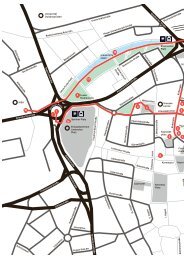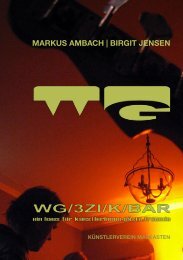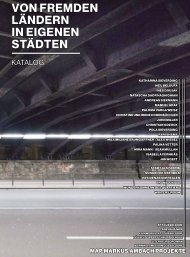B1|A40 THE BEAUTY OF THE GRAND ROAD
DIE SCHÖNHEIT DER GROSSEN STRASSE 2014 EINE AUSSTELLUNG IM STADTRAUM DER A40 VON DUISBURG BIS DORTMUND 14.06.2014 – 07.09.2014 MAP MARKUS AMBACH PROJEKTE URBANE KÜNSTE RUHR (HG.) WIENAND
DIE SCHÖNHEIT DER GROSSEN STRASSE 2014
EINE AUSSTELLUNG IM STADTRAUM DER A40 VON DUISBURG BIS DORTMUND
14.06.2014 – 07.09.2014
MAP MARKUS AMBACH PROJEKTE
URBANE KÜNSTE RUHR
(HG.)
WIENAND
Create successful ePaper yourself
Turn your PDF publications into a flip-book with our unique Google optimized e-Paper software.
trial-looking buildings or to the production<br />
conditions of the bee colony described on a<br />
billboard is of little consequence to the bees,<br />
whose “economic commodities” are still eminently<br />
marketable in Germany’s first – and still<br />
prospering – “shopping city” located in the no<br />
longer green belt. The information that one of<br />
their current areas of settlement and production<br />
is for once located near the almost proverbial<br />
gridlock sections of the “beautiful” road<br />
might for a moment confuse the customers.<br />
Yet it could be argued that even in the midst<br />
of unregulated and creative nature, this particular<br />
highly intelligent “travelling people” is<br />
demonstrating the superiority of its own individual<br />
model of value creation and exploitation<br />
of resources over those of regulated society.<br />
Those who are repulsed, after partaking of<br />
this special offer or any of the conventional<br />
merchandise offered by such shopping malls,<br />
by the prospect of having to face the gridlock<br />
on the A40 or the crowding in the underground<br />
trains may find an alternative in Andreas Wegner’s<br />
Paketdienst Esso 36 (Esso 36 Parcel Service)<br />
(2010), offering a comfortable and ecologically<br />
viable journey in a horse-drawn carriage.<br />
In former times the mail coach used to be a<br />
handy means for acquiring riches for some intelligent<br />
members of the aspiring bourgeoisie;<br />
the traditional “travelling people”, also called<br />
vagabonds, would have deemed such rides in a<br />
horse-drawn carriage a nonpareil luxury until<br />
the late 19th century.<br />
The journey could for example lead to the<br />
nearest inn whose staff, in former times,<br />
would have been quick to serve the coachmen<br />
and their customers, if also their readiness to<br />
bring viands outside for the others was probably<br />
merely driven by the desire to get rid<br />
of these thieving vagabonds again as quickly<br />
as possible. Seen from this perspective, the<br />
project of the grand road has been offering,<br />
in both of its stages, a range of refreshments,<br />
simultaneously pleasurable and physically and<br />
mentally invigorating, ranging from picnics<br />
and leisure activities to booze cruises, both to<br />
well-informed guests and accidental passersby.<br />
Wherever the tired traveler arrives, he will<br />
find hospitality, whether at Atelier van Lieshout’s<br />
Motel Bochum, Delikatfisch Braun, the<br />
fish farm located close to the famous spaghetti<br />
junction at Duisburg-Kaiserberg in a veritable<br />
self-made paradise, or Jeanne van Heeswijk’s<br />
Gallic table at Duisburg-Werthacker.<br />
Where Der Widerstand des kleinen Glücks (The<br />
Resistance of Small Happiness) put up by the<br />
new settlers is defending the last remaining<br />
open spaces in an economic metropolis,<br />
its highly symbolic setting in a combination of<br />
autonomous sculpture to functional furniture<br />
also serves in 2014 as a hospitable meetingpoint<br />
for the big spaghetti dinner – a tonguein-cheek<br />
reference to the aforementioned<br />
labyrinth of intertwining roads. The “Outside<br />
Inn”?! Once the boundaries get blurred, the<br />
hour of the showmen, anarchists and other<br />
service providers has come.<br />
The wheels which were set in motion in 2010<br />
are gathering pace in 2014. Possibly the discrepancy<br />
between the fear of strangers and the<br />
curiosity about what they are contributing to<br />
contemporary urban society has become more<br />
marked over that period and accordingly subconsciously<br />
influences the perception – also<br />
that of the author of this text – of the beauty of<br />
the grand road as an area of untapped opportunities.<br />
Take the Mülheim-Eichbaum metro station:<br />
one of those rather dilapidated transport junctions<br />
in the middle of nowhere, halfway between<br />
Mülheim and Essen. On the left hand,<br />
the traveller coming from Mülheim will see a<br />
field bordered by a row of houses; to the right<br />
a makeshift asphalt track leads through a<br />
wooded section – whether it actually leads to<br />
build-up areas can be determined only once<br />
the metro travelers start to disperse. In 2009,<br />
showmen staged an opera here. The first actors<br />
were paid, grant-aided artists; yet the success<br />
of the by now legendary Eichbaum Opera<br />
was above all guaranteed by the participating<br />
residents from both sides of the motorways<br />
and metro lines. Its remnant is a strange<br />
construction, half container and half lookout<br />
platform, maybe also some kind of director’s<br />
roost. By now, the Opernbauhütte (opera shed)<br />
erected by raumlaborberlin as a temporary<br />
construction (2008 – 2010) has been gold-plated<br />
by Martin Pfeifle and Wanda Sebastian; accordingly<br />
the author is invariably reminded by<br />
129












